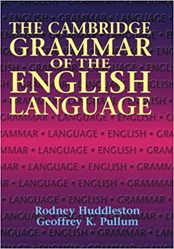Lesson Notes: Syntax 1
Note: The Slideshow 2 mode is the easiest way to advance to a particular slide. The slide number is shown in the bottom right corner of the slide and the slide counter is shown on the left under the slide.
Slide 4
Matrix clause
In modern analysis a matrix clause is a clause that has a subordinate clause embedded in it.
Aarts in Oxford Modern English Grammar (page 82) prefaces his explanation of the term with this example sentence:
- 168 I think [that this poem justifies his point].
He continues:
"We can represent the structure of 168 as follows:

We refer to a clause in which a subordinate clause is embedded as a matrix clause. A matrix clause which is itself not embedded within any other clause is called a main clause. Thus in 168 the string I think that this poem justifies his point is a main clause and a matrix clause, whereas the string that this poem justifies his point is a subordinate clause."
Non-finite clause
The Oxford Dictionary of English Grammar (page 270) defines a non-finite clause as follows:
"A verb form that is not marked for tense; contrasting with finite.
The term covers the infinitive forms of verbs (the to-infinitive and bare infinitive) the -ing form, and the past participle, as well as associated clauses containing these forms.
- To expect a refund is unreasonable.
- All he ever does is complain.
- Having said that, I still hope he gets his degree.
- If consulted, I will advise against it.
A non-finite clause can perform various functions, such as subject (as in the first example above), complement (as in the second example) or adverbial (as in the third and fourth examples)."
The dictionary goes on to note that not all grammarians agree on the nature of non-finiteness.
Here you can read more on matrix clauses and non-finite clauses.
Slide 20
The note on the slide states: Some modern grammarians have re-classified most of the conjunctions listed above as prepositions.
The conjunctions listed on the slide are: after, although, as, because, before, if, once, since, than, that, though, unless, until, when, whenever, where, wherever, while.
Of these, all but if and that have been reanalysed as conjunctive prepositions by Aarts in the Oxford Modern English Grammar (section 5.5.1,5).
Slide 22
The note on the slide states: Not all grammarians list compound-complex sentences as a separate category in their own right. Instead, sentences of the type shown here are included in the complex category.
Indeed, some authoritative grammarians reject the whole basis of classifying sentences according to the analysis presented in this lesson. Two such grammarians are Huddlestone and Pullum in Cambridge Grammar of the English Language (CGEL).
In a footnote* on page 45 of the CGEL section covering Sentence and clause they state:

"Traditional grammar classifies the sentences in [1*] as respectively simple, complex and compound, but this scheme conflates two separate dimensions: the presence or absence of embedding, and the presence or absence of coordination. Note that in I think Jill seems quite friendly, but her husband is extremely shy there is both embedding and coordination. We can distinguish [i-ii] from [iii] as non-compound (or clausal) vs compound; [i-ii] could then be distinguished as simple vs complex clauses but no great distinction attaches to this latter distinction, and we shall not make further use of these terms."
* The sentences in [1] referred to in the footnote are:
- Jill seems quite friendly.
- I think Jill seems quite friendly.
- Jill seems quite friendly, but her husband is extremely shy.
Slide 31
Here is the full answer provided by ChatGPT to the question: In what contexts can fragment sentences be justified?
Fragment sentences, lacking a complete subject or verb, can be frowned upon in formal writing. However, they hold power when used strategically. Let's explore when their use is justified:
1. For Emphasis and Impact:
- Highlighting key points: Fragments can isolate and emphasize important ideas, making them stand out like dramatic spotlights. Example: Never give up. Never surrender. (Winston Churchill)
- Creating urgency or suspense: Short, incomplete sentences can build tension and anticipation, leaving readers wanting more. Example: Footsteps. Closer now. Heart pounding.
- Adding a conversational tone: Fragments mimic natural speech, making writing feel more informal and engaging. Example: You know, sometimes the best things happen when you least expect them.
2. For Creative Expression:
- In poetry and song lyrics: Fragments break from traditional sentence structure, adding rhythm, rhyme, and emotional depth. Example: The fog creeps. Silent and cold. A shiver runs down my spine.
- In dialogue and dramatic writing: Fragments can capture raw emotions, hesitation, or interrupted speech, adding realism to characters and scenes. Example: "Wait! Don't leave..." she pleaded, voice trembling.
- In flash fiction and microfiction: Fragments condense narratives, creating impactful stories within limited word counts. Example: Rain lashed. Wind howled. Lost, alone, she found solace in the storm.
3. For Technical Writing:
- In instructions or lists: Fragments can present steps or information concisely, improving readability and scannability. Example: Preheat oven to 350°F. Combine ingredients. Bake for 20 minutes.
- In headings and captions: Fragments can grab attention and convey key information quickly. Example: New breakthrough in cancer research. Hope for millions.
Remember:
- Use fragments sparingly and purposefully. Overuse can disrupt the flow and clarity of your writing.
- Consider your audience and purpose. Fragments might not be suitable for formal contexts or complex topics.
- Proofread carefully to ensure fragments are intentional and grammatically correct.
In conclusion, fragment sentences, when used thoughtfully, can be powerful tools for emphasis, creativity, and clarity. Master their use, and you'll add a dynamic spark to your writing.
Slide 35
Here is the link to the page containing writing advice based on understanding of the seven sentence structures analysed in this lesson.